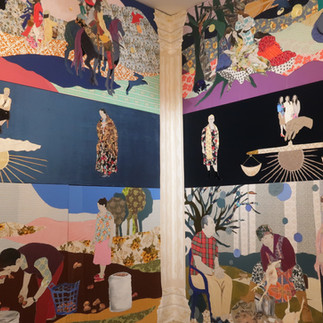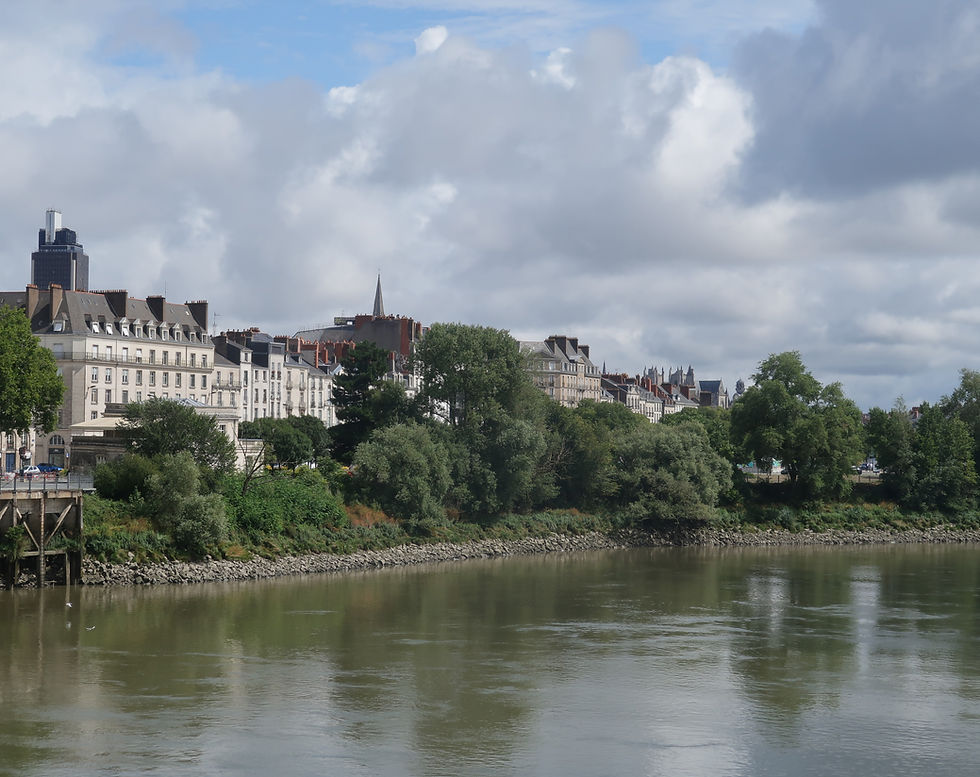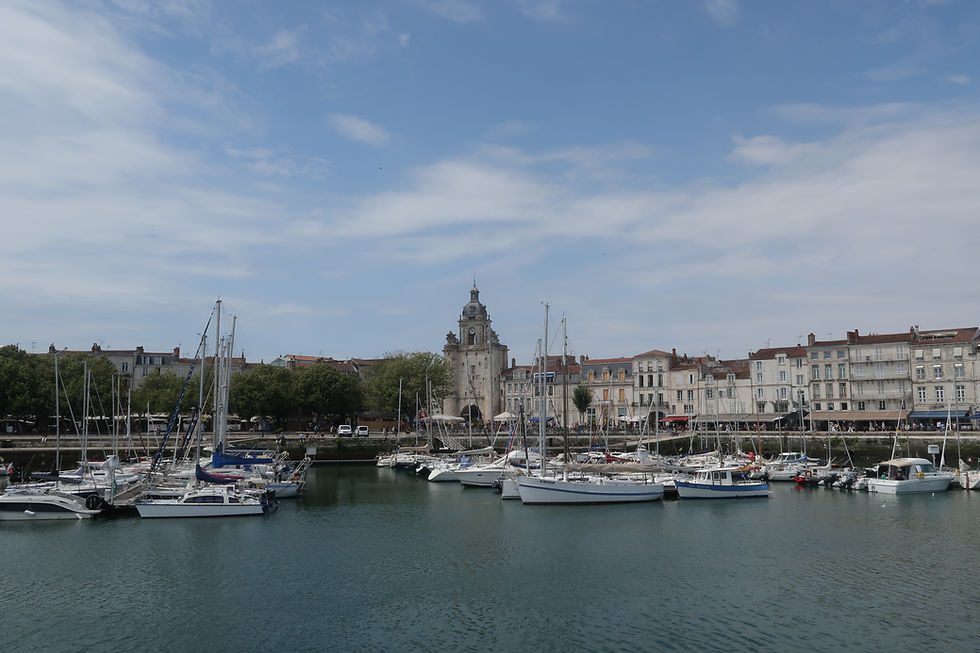Autumn in Venice: it's Biennale time
- Karyn Farrell
- Nov 22, 2022
- 10 min read
Updated: Sep 28

It's an autumnal Sunday morning in Venice. Church bells are ringing as we crunch through the leaf-strewn paths of Castello to catch the Vaporetto after an art-filled weekend. But first - one final breakfast at our favourite neighbourhood spot Vincent Bar, where service always comes with a friendly smile. Coffee is excellent, courtesy of Italy's oldest roastery Caffé Vergnano, dating to 1882. But it's the warm pistachio croissant that sets it apart. Oh my!

A firm favourite on a previous visit, Vincent Bar is tucked away under some trees on the edges of the Giardini Pubblici. With views across the lagoon, this is a gem of a place with an almost entirely local clientele. Staff are warm and friendly, and the Campari Spritz is one of the best in the city - a snip at €4. It's also a great spot for lunch with warm focaccia panini and huge meaty olives. Excellent value for money too - no tourist prices here. It's also just metres away from Sant' Elena, one of the new entrance points to the Giardini venue of the Biennale.
Vincent Bar, Viale IV Novembre, 36
An extended visit in 2021 offered the perfect opportunity to really get to know this city (you can read my full rundown here.) And by that I mean getting off the main tourist drag and finding the 'Real Venice'. And I think we found a little bit of it here on the peaceful and colourful streets of Castello.
Venice is made up of a series of neighbourhoods or sestieri which are all interlinked by bridges and accessible from each other on foot: Cannaregio, Castello, San Marco, San Polo, Santa Croce and Dorsoduro. Last time around, Castello was the neighbourhood that stole my heart. This time, we made it our home for four days. The easternmost and largest district of Venice, it is home to the Arsenale shipyards, the heart of the naval industry in Venice from the 12th century.

Today of course, it's synonymous with the Venice Biennale which runs from May to November, showcasing art and architecture on alternate years. A huge draw for tourists, both national and international, it attracts over half a million visitors each year. The best time to visit, not only the Biennale but Venice as a whole, is late September or October. At this time of year, temperatures have cooled a little while still remaining pleasantly warm by day. Most importantly, this off-peak season brings a welcome lull in tourist numbers and a much more enjoyable Biennale experience without the epic queues.

Armed with a three-day ticket and two best friends in tow, I finally got to experience this world-class cultural extravaganza this year, showcasing some of the world's most renowned contemporary artists in multiple venues across the city.

Yunchul Kim, Korean Pavilion
2022 saw the return of Biennale Arte. Whether art is your thing or not, you can't fail to be wowed by a spectacle of this scale, and the Venice Biennale is definitely a bucket-list experience. With a wide-ranging exhibition of painting, sculpture, video and conceptual art, there's something for every taste.
The two main exhibition venues are Arsenale and the Giardini della Biennale but there are also collateral shows popping up all over the city in galleries, museums and other impressive venues. If time is on your side, opt for a three-day ticket and explore at your leisure. There are plenty of places to stop for a coffee or indeed an early afternoon Spritz, if energy levels start to wane.
A three-day, multiple access ticket will set you back €35, allowing you to come and go as you please. If time is limited, a single-access ticket costs €25, valid for one visit to the Giardini venue and one to Arsenale. To maximise your time, consult the online brochure in advance and make a priority list of the ones you simply must see. It's worth noting that
Giardini is the smaller and more accessible of the two sites.
Ticket sales are exclusively available online
Giardini della Biennale
Though some parts are inaccessible without a ticket during the Biennale, you can still enjoy strolling the length of this lovely tree-lined avenue and public park for free. The main thoroughfare opens out to some of the most stunning views imaginable across the Venetian lagoon, and autumn is a fabulous time to visit when the leaves are really putting on a colourful show. Make sure to look out for the turtles in the fountain at the entrance - Venice is always full of surprises.
Exploring the diversity of art on show in the various pavilions in the Giardini della Biennale was a joyous experience. Pebbled walkways weave through the gardens, lined on either side by exhibition spaces representing twenty-eight countries worldwide, while a central pavilion hosts the work of another fifty two artists. It's a beautiful setting, lined with trees, and a canal running through the heart of it.
Every pavilion is unique, each showcasing the work of one artist. Fortified by a prosciutto & mozzarella panino and a lunchtime Campari Spritz, we giddily consulted our maps and prioritised our must-see countries. Brazil certainly made a fun first impression with two outsized ears framing the entrance and exit. With the Heart Coming Out of the Mouth was our introduction to the Biennale, the work of Brazilian artist Jonathas de Andrade. Here's a little taster of what to expect throughout.

Simone Leigh, United States pavilion
Personal highlights: Giardini
Simone Leigh was the one everyone was talking about. Representing the United States, her monumental Black female figures exude a quiet presence and power, and are extraordinarily beautiful. Her work also features prominently in the Arsenale venue.
Everyone walked out of the Belgian pavilion with a great big smile on their face. Featuring paintings and video pieces by Francis Alÿs, The Nature of the Game has children at play as a running theme. His exquisite tiny paintings document a child's ability to make their own fun, even in regions of conflict, while the soft pastel tones belie the serious subject matter.
His films continue the theme. Children of different cultural backgrounds from all over the world show their inherent communality through play, making up games and finding joy in the harshest of situations. His cinematography is glorious too: engaging and an absolute feast for the eyes.
Polish Pavilion

Step into the Polish pavilion and immerse yourself in the stories of Małgorzata Mirga-Tas. This vibrant installation is a document of Roma culture and features twelve panels depicting the months of the year in large-format textiles. The level of detail is extraordinary and the characters are captivating. One of the highlights of the entire trip.
On a more sombre note, the Russian Pavilion lay empty. The curator and artists withdrew their participation, in an act of solidarity with the Ukrainian people.

The Giardini della Biennale venue is easily accessible by Vaporetto, nestled between the Giardini and Sant' Elena stops and with entrance points at both ends.
Nearby, the striking setting of the Serra dei Giardini thwarted any plans of food shopping or any such practical considerations. Instead, the spectacle of this magnificent Victorian-style glasshouse, illuminated beautifully against a clear evening sky, lured us cunningly to one of their tables on the terrace and to a round of some seriously potent Negronis.

Serra dei Giardini is a fabulous public amenity with a permanent display of unusual plant species, but it also functions as an educational space for schools, adults and families, and as a cultural centre. Appetite sufficiently whetted, a short walk through the Giardini della Biennale will bring to you one of the city's coolest streets for dining and drinks - Via Giuseppe Garibaldi.
Serra dei Giardini, Via Giuseppe Garibaldi, 1254
Eating and Drinking on Via Giuseppe Garibaldi
Via Giuseppe Garibaldi is the beating heart of Castello, a street teeming with life from 6pm every day when aperitivo time is in full swing. Start at the waterfront where it meets Riva Sette Martiri, and make your way along the 'Castello Cicchetti Trail'. Cicchetti are a form of Venetian tapas: small snacks to be enjoyed with a drink. Here you'll find a strip of bars with street-side tables offering a range of cheap and cheerful bites with your aperitivo. Basegó and Strani are two of the most popular with an excellent selection of beers on tap, as well as reasonably-priced glasses of Veneto wines. Make sure to try the baccalà mantecato, the traditional Venetian whipped salt cod dish - it's divine, and melts in the mouth.
Salvmeria
Book ahead to nab one of the in-demand street side tables at Salvmeria, a popular contemporary Venetian bacaro. Offering a small selection of traditional, seasonal dishes with a modern twist, ingredients are locally-sourced, flavours are fresh and innovative and service comes with a smile and a healthy dose of humour.

This once historic delicatessen has been given a new lease of life but with a respectful nod to tradition. They have a small but carefully-chosen wine list and the atmosphere is buzzy and convivial. A little gem.
Salvmeria, Via Giuseppe Garibaldi, 1769
Arsenale

Day two and it's time to explore Arsenale, the larger of the two Biennale venues with the work of over 100 artists on show. To the north, entry is from Arsenale Nord or Ponte dei Pensieri (ACTV stop: Bacini) To the west, entry is at Arsenale (ACTV stop of the same name). A useful insider's tip: the venue operates a free shuttle service every 20 mins from one end to the other. It's quite a trek to cover the full distance so if you're short on time, this could be a lifesaver.

Simone Leigh, United States
Entering from the north, you'll start your visit among the leafy surrounds of the Giardino delle Virgini. In 2022, Simone Leigh's striking gold figure was a standout piece, emitting an incandescent glow under a canopy of lush greenery.
In a secluded garden off the Giardino delle Vergini, the installations of American artist Marianne Vitale were unmissable, lamenting the collapse of contemporary Western society and the ravages of climate change.
Arsenale 2022: personal highlights
Uzbekistan Pavilion

The remarkable Garden of Knowledge in the Uzbekistan pavilion was a mind-melting, disorienting experience, its mirrored steps giving an illusion of stepping into the abyss.
Corderie Central Pavilion
The Corderie Central Pavilion is the largest exhibition space, hosting the work of over 80 artists in a series of adjoining rooms. One of the standout installations for me was the remarkable series by Argentinian Gabriel Chaile. Giving a nod to traditional clay pot techniques, his five monumental sculptures are personifications of family members. In contrast, Ruth Asawa's delicate suspended wire sculptures are mesmerisingly beautiful with an ethereal quality.
Sweden
The embroidered works by Britta Marakatt-Labba tell stories of the Sámi Indigenous community and the Nordic landscape. The level of detail achieved on such a tiny scale is simply extraordinary.
The show at Arsenale ends as it starts, with a monumental bronze figure by Simone Leigh. Brick House is a showstopper: a powerful Black woman dominating the octagonal exhibition space, both physically and emotionally. The original edition was commissioned for the High Line in New York City in 2019, towering above Manhattan’s busy 10th Avenue.
Simone Leigh, Brick House
Day 3 - time to enjoy some of the collateral events happening across the city in museums, palazzi and commercial galleries. Isola San Giorgio, one of the city's most iconic locations, played host to a wonderfully varied solo show by renowned Chinese artist and activist Ai Weiwei.
In the splendid surroundings of Palladio's Basilica di San Giorgio Maggiore hangs his pièce de résistance, the largest suspended installation in Murano glass ever made comprising over 2000 pieces of black handmade glass.
'La Commedia Umana: Memento Mori' Basilica di San Giorgio Maggiore. Until 27 November 2022
Anselm Kiefer at Palazzo Ducale

'These writings, when burned, will finally cast a little light'
Utterly unmissable is the site-specific installation in the Palazzo Ducale by one of the world's greatest living painters, Anselm Kiefer. Reimagining the city's centuries-long history against a backdrop of the magnificent Sala dello Scrutinio, the artist has produced arguably his best work to date. Fourteen monumental paintings fill the space from floor to ceiling, a powerful and immersive experience for the viewer.
Allusions to Venice are everywhere, most notably the empty casket of St. Mark, Venice’s patron saint, and the fire that ravaged the city in the 16th century causing severe damage to the Doge's Palace. But aside from the layers of philosophical references and hidden meanings, in essence these are beautiful luminous paintings which speak to your soul. You'll walk away feeling that you've witnessed something truly special.
And the good news is, its run has been extended to January 2023. Catch it while you can.
From 26 March 2022 to 6 January 2023 | Entrance exclusively with ticket to Palazzo Ducale - €31
It's always worth checking out what's happening in the Palazzo Grassi and Punta Della Dogana, two cutting edge contemporary art museums showcasing both personal and collective exhibitions.

Palazzo Grassi is an elegant Classical building right on the Grand Canal while Punta della Dogana is one of Venice's old customs buildings. Both have been beautifully renovated by renowned Japanese architect Tadao Ando and have built up solid reputations for their excellent artistic programming.
We were lucky enough to catch a retrospective of South Africa's Marlene Dumas, a wonderful exhibition of paintings and drawings from 1984 to present day. Her portraits are hugely affecting, drawing on the entire gamut of human emotion and experience. The show continues until Jan. 2023.
At Punta della Dogana, Bruce Nauman's 'Contrapposto Studies' runs until 27th November 2022.
Palazzo Grassi, Campo San Samuele 3231, San Marco: Vaporetto: San Samuele / Sant'Angelo
Punta della Dogana, Dorsoduro 2: Vaporetto: Salute
It's a short walk between the two museums and a particularly scenic one. From Palazzo Grassi in San Marco, don't miss the opportunity to cross the magnificent Ponte dell' Accademia. Pause to take in the vast expanse of the Grand Canal before crossing over to Dorsoduro, one of the city's most picturesque neighbourhoods.

View of Grand Canal from Ponte dell' Accademia
As evening dawns on this magnificent city, there is no better place to sip a canal-side Spritz or two than the Fondamenta delle Zattere on the southern side of Dorsoduro, watching the sun set over Giudecca and the lagoon beyond.
With outdoor tables running along the waterside, El Chioscetto is beloved of locals, students and tourists alike, serving up inexpensive drinks and free snacks from a vibey little kiosk. Service is warm and friendly and with views like these, it can be hard to drag yourself away.
El Chioscetto, Fondamenta Zattere Al Ponte Lungo, 1406/A
One last lunch before we go...

The alluring canal side tables of Km0 Venezia Osteria caught our eye as we crossed the Ponte Santa Chiara o del Monastero. On a balmy Sunday afternoon, a crisp Rosé Bardolino hit the spot, while plates of Penne Arrabbiata and spaghetti with juicy prawns made for a perfect last meal. Excellent value for money too. The location is picture-perfect, nestled in a quiet and colourful corner of Santa Croce, beside the Giardini Papadopoli. It's a short walk from the train and bus stations at Santa Lucia and Piazzale Roma.
Km0 Venezia Osteria, Santa Croce 270/F, Fondamenta Giardini Papadopoli
Venice - 1500 years worth of secrets and beauty: a fun and interactive scavenger hunt
Interested in seeing one of the most lavish hospitals in the world? Or a tower designed to be climbed on horseback. What about a submerged crypt? ClueGo trail is a fun app to use on the go. Part self-guided tour and part scavenger hunt, the app allows you to have an immersive and interactive experience through the city, following a trail of fascinating stories. Your powers of observation and creativity will be tested to solve the clues and riddles to get from one destination to the next. It's a fun and unique way to experience a city, and you can do it at your own pace.
Price: €17.99 for a max group of 5 people. It's a 3.5 km trail with 11 stops and 11 riddles. Join the fun here
Good luck!









































































































































Comments